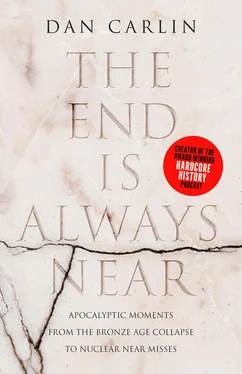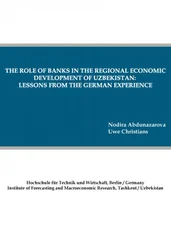There are some incidents of mass fatality–level famine in modern advanced cities or states in the mid-twentieth century. The unusual sight of humans dying from starvation next to modern buildings and on modern streets clashes with the image in our minds of poor, war-torn, drought-stricken, underdeveloped societies on the edge of the globalized world. We are conditioned to think that way by recent history. It’s hard to picture London or Tokyo or New York with mass deaths in the street from starvation.
But that’s the human experience that we need to imagine when thinking about famine. The tales that modern observers and victims of famine tell are of societies that fall apart because there’s no food. Imagine if the region where you live were cut off from food supplies today. As Garry J. Shaw suggests, it might explain why you get sea peoples, migrations, invasions, or insurrections.
When enough people are driven by desperation, not even the greatest state can stop them; symbols of wealth and prestige mean nothing if enough people reject their meaning. In such times, some will rise up, burn, and rebuild on the ashes. Others will leave. And so, in this time of instability, disease, violence, famine, and drought, the assorted ‘Sea Peoples’ took the second option: they travelled eastwards, bringing their families and possessions along with them, leaving their homeland behind. To support themselves or when attempting to settle, sometimes they turned to violence, probably supported by mercenaries, creating their legend.
There’s good evidence for famine during the last few centuries of the Mediterranean Bronze Age in many places around the region. The Hittites, especially, seemed to be facing a dire food crisis over an extended period; a last desperate letter sent from the capital, before the destruction of the city, refers to starvation. In Egypt, cemetery finds show evidence that the population of this era often suffered malnourishment. And people from Libya seemed to always be threatened by hunger; they would raid or even migrate to Egypt periodically over many centuries for food. [27]
Lots of things can cause famine. Insects can eat or spoil food; rivers and water sources can dry up or change course, or complex irrigation systems can be destroyed; poor farming practices can deplete the soil. Usually, though, the weather itself is the greatest threat. Even in the modern age, the utter dependence of agriculture on the right range of favorable climatic conditions is humbling. No nation is immune. Arid weather in the American Midwest created the Dust Bowl of the 1930s, during the Great Depression, which in turn spawned a migration of people and sent forth ripples of historical change that are still felt today. Similar events must have happened innumerable times in humanity’s past.
Weather-related explanations for the end of the Bronze Age are extrapopular right now given the general spotlight on climate change, but historians for many decades have theorized that drought was what really unleashed the Four Horsemen. A prolonged drought, leading to severe famine, could certainly have been the spark that set into motion chain reactions that in retrospect explain things like piracy, migrations, and perhaps internal unrest.
As the historian Malcolm H. Wiener writes: “Warfare and migrations may be both the result and the cause of food crisis, and particularly where the carrying capacity of the land is already stretched to the utmost. The effects may be cumulative, with food shortages leading to overuse and degradation of available land; to rebellions by troops, populace, or captives; and/or to the loss of legitimacy of rulers believed to have lost divine favor.”
It’s hard to know how much localized famine was normal and to be periodically expected, and how much a particularly bad situation represented an unusual larger threat. Studies have shown evidence of a prolonged drought roughly around the relevant time in some of these areas. [28]
A counterargument by some experts, however, is that droughts are not uncommon in this climatic zone, because much of the eastern Mediterranean is somewhat arid to begin with. Why, suddenly, did a particularly dry period bring down a chain of ancient societies in a region where droughts weren’t so terribly rare? And why, if drought explains why peoples began to relocate, did those people sometimes leave known dry areas and migrate to ones that have been shown to be even more arid? [29]
Famine prompts a similar question: If famine wasn’t that rare, why did it topple the structure at the end of the Bronze Age rather than any of the other times it occurred? It certainly may have done so, but proving it is the task still facing historical investigators.
If something like drought or famine was the cause of the Bronze Age collapse, it didn’t wreak its changes by starving everyone to death. Famine would have been more of a spark that set off side effects. Yet it’s terribly difficult, especially thousands of years later, to tie the ripple effects back to whatever rocks were first thrown into the stream. How do you connect the dots, for example, between an attack by the sea peoples and evidence of a drought in their homeland? Having relatively accurate dates for when events occurred would be of great help solving such a puzzle. A drought, for example, a hundred years after the sea people invasions, couldn’t possibly have been its cause, but if it happened ten years before the great attacks chronicled by the pharaohs, then it might indeed have spurred a subsequent migration. But how close can science get to actual specific years when something occurred more than three thousand years ago?
That leads to the next suspect:
Suspect #3: Earthquakes/Volcanoes/Tsunamis
First, let’s step out of our timeline to the year 1815, when the Mount Tambora volcano erupted in what’s now part of Indonesia. It is the only eruption in the last thousand years that merits a 7 out of a maximum 8 rating on the Volcanic Explosivity Index (VEI). [30]It caused tsunamis and earthquakes, darkened the skies, and unleashed enough ash to cover a one-hundred-square-mile area to a depth of twelve feet. The effect on global climate was profound—1816 was known as “the year without summer.” And, among other things, it was thought to have brought on famine.
There have only been a handful of volcanic eruptions to reach that high on the VEI since humans began keeping a written record of their history. One happened near the end of the Bronze Age, in the eastern Mediterranean, in an area that was right at the heart of the whole Mediterranean Bronze Age world.
Today, the location of the volcano is actually the Greek island of Santorini, but the ancient Greeks called the island Thera. Like Tambora, the Thera eruption was one of the most powerful volcanic events in human history; unlike Tambora, we have no surviving contemporary accounts of it. Scientists can find the evidence of its eruption all over the region, but they can’t yet pinpoint the year it happened. If they could, it would become a specific marker that would help date other events. [31]Experts can get close to a date, within a century or so—usually between about 1630 and 1500 BCE—but while that’s a tiny margin of error when compared with the intervening thousands of years, it’s still enough to muddy this investigation. Since the fall of the Bronze Age is usually dated to around 1200 BCE or so, the later the eruption is dated, the more likely it is to have had an effect on the catastrophe. [32]
Experts argue about most things connected to the Thera eruption. In addition to the dating, the amount of damage done to the surrounding areas is in question. If it somehow played a role in the downfall of that age, how did it do so? Tsunamis are one proposed vector of destruction. That one or multiple tsunamis were generated by the eruption seems universally accepted, but disagreements occur over their size and what sort of damage they would have caused. Most of the Thera volcano’s tsunamis would have been created by the quick addition of massive amounts of material into the sea, which generates waves that can reach enormous heights (the same way that a glacier’s calving produces large waves). [33]These waves, known as megatsunamis, are quite different from the more familiar seismic variety of tsunami. Whereas the seismic tsunamis are almost too small to be noticed while moving through the open sea, and they explode in height only when they approach land, megatsunamis start at maximum height upon generation and lose force and height as they move across miles of water. Seismic tsunamis are often preceded by a strange receding of the beach tide, only to have the water roar back later, but megatsunamis are more like rogue waves—they can come out of nowhere.
Читать дальше











